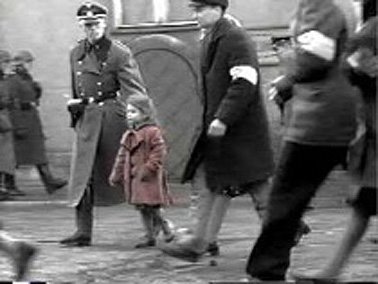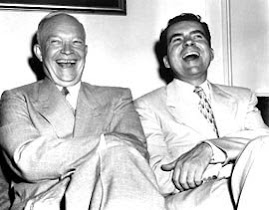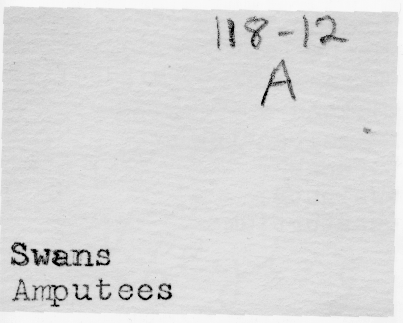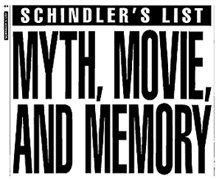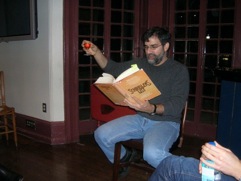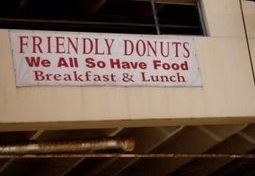 Pier Marton's film Say I'm a Jew is about Marton's inability to talk about the Holocaust. He is a child of survivors and found that he could not talk articulately at all about it, so he decided to talk about that--his inability to talk about it. And about the inability to talk he could talk about freely.
Pier Marton's film Say I'm a Jew is about Marton's inability to talk about the Holocaust. He is a child of survivors and found that he could not talk articulately at all about it, so he decided to talk about that--his inability to talk about it. And about the inability to talk he could talk about freely. The film is 28 minutes and can be viewed (in RealVideo format - for which you need a "RealPlayer") - on Marton's web site. Look for a link to Say I'm a Jew on the right side of the page.
Here's what Stephen Feinstein has written about Marton in Witness and Legacy: "Pier Marton is a second-generation artist who has wrestled with problems of his parents' survival and the impact of contemporary anti-Semitism. This led him to merge the video interview of children of survivors, called Say I'm a Jew, with an installation entitled Jew, set in a cattle car. Being a member of the second generation and experiencing European anti-Semitism in France in the 1950s and 1960s led Marton to the inability to openly express his Jewishness. Drawing from his own experience, Marton was obsessed with the question of how children of the second generation have coped with growing up in Europe after World War II. While attending a convention of second-generation survivors, Marton advertised for individuals willing to tell the story of their European and Jewish identity experiences on camera. Many volunteered. Marton edited bits and pieces of the video together to form an engaging artistic and psychological work. The American-European painter R. J. Kitaj has represented what he terms "diasporism" as a major component in contemporary artistic life. This is a useful concept to explain the works of many artists in this show, who constantly have to deal with a Jewish identity problem in a world that is potentially enticing and supportive and also contains anti-Semitism, denial and insult. Marton's space was made to represent a blend of cattle car, barracks and a mausoleum. As Marton has written, "Memory can fuse separate locations in an inextricable blend." Within the installation area were seats where the video played continuously. Those attending the show were encouraged to write their responses on the walls of the entrance and boxcar itself, recalling the memory of how deportees did the same on their way to death camps."






 "I teach horizontally, meaning that while I might begin with a fixed idea of what I'm going to teach that day, I let it drift rhizomatically way off topic, often pulling it back when it gets too far. I rely on non-fixed materials to teach this way; the whole world is at my fingertips. Should I go off on a tangent about John and Rauschenberg and their love relationship as expressed in Rauschenberg's bed, an image of that bed is always a click away. From there, we can head anywhere into the non-fixed universe, be it film, text or sound. And of course, that always takes us elsewhere. As Cage says, 'We are getting nowhere fast.'"
"I teach horizontally, meaning that while I might begin with a fixed idea of what I'm going to teach that day, I let it drift rhizomatically way off topic, often pulling it back when it gets too far. I rely on non-fixed materials to teach this way; the whole world is at my fingertips. Should I go off on a tangent about John and Rauschenberg and their love relationship as expressed in Rauschenberg's bed, an image of that bed is always a click away. From there, we can head anywhere into the non-fixed universe, be it film, text or sound. And of course, that always takes us elsewhere. As Cage says, 'We are getting nowhere fast.'" 

 that anyone has yet got the imaginative measure of that terrifying day six years ago. Certainly our Tolstoy has not crawled out of the rubble. The closest we have, Don DeLillo, succeeded as an essayist-journalist ("In the Ruins of the Future: Reflections on Terror and Loss in the Shadow of September,” Harper’s, December 2001) but, to my mind, failed as a novelist ("Falling Man"). One reason, perhaps, is that the remembered emotion was instantly buried under a pile of cultural junk.' - Tod Gitlin in his review of Susan Faludi's The Terror Dream (written for
that anyone has yet got the imaginative measure of that terrifying day six years ago. Certainly our Tolstoy has not crawled out of the rubble. The closest we have, Don DeLillo, succeeded as an essayist-journalist ("In the Ruins of the Future: Reflections on Terror and Loss in the Shadow of September,” Harper’s, December 2001) but, to my mind, failed as a novelist ("Falling Man"). One reason, perhaps, is that the remembered emotion was instantly buried under a pile of cultural junk.' - Tod Gitlin in his review of Susan Faludi's The Terror Dream (written for 


